How A Wrigley Ocean Marathon Win For ‘Zimmy’ Off Catalina in 1927 Might Have Changed The World
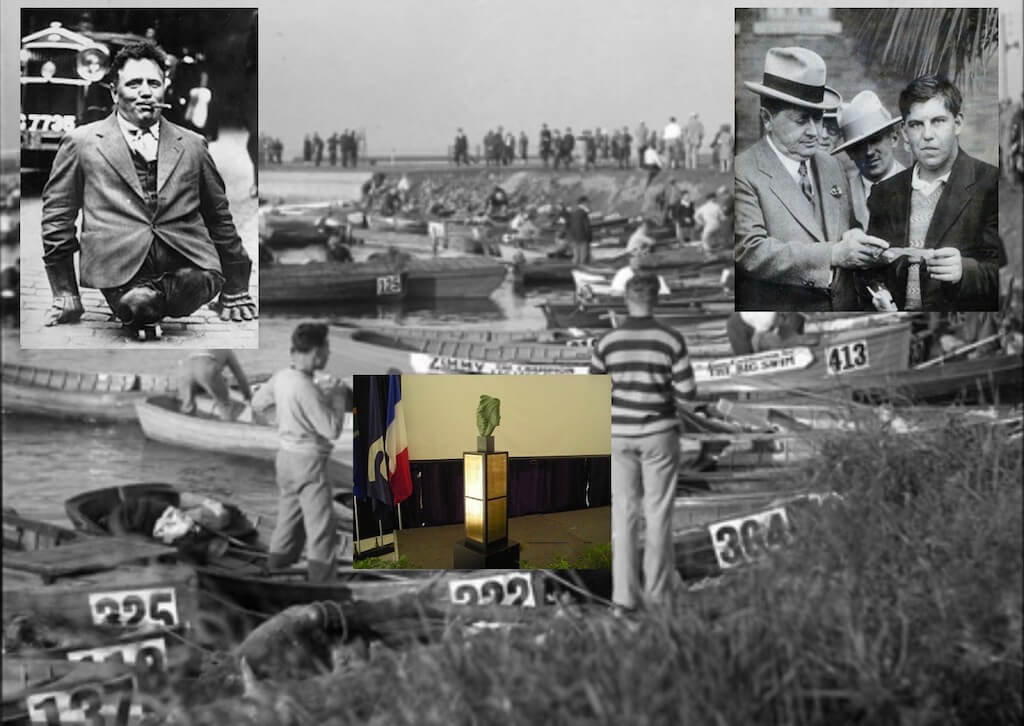
In 1927, 17-year old Canadian George Young famously won The Wrigley Ocean Marathon across the Catalina Channel sponsored by the chewing gum magnate William Wrigley Jnr. Had Charles ‘Zimmy’ Zibleman won the race, the changes that would have brought about in Marathon and Disability Swimming might well have spilled well beyond the water. Here, a team of marathon devotees looks at why and how.
by IMSHOF Honorees Penny Lee Dean and Conrad Wennerberg, who provided the key details for this feature.
Thanks are also due to Ros Hardiman, Honorees David Stevens Clark, Steven Muñatones, Richard Broer, Dr. David Smith and Ned Denison for helping to bring together the threads of this swimming history
The Sea Goddess (right) is the official trophy for the International Marathon Swimming Hall of Fame (IMSHOF). The names of all Honorees are engraved on the 2-meter high sculpture, which is housed in an ISHOF museum in Florida about to get the facelift of its lifetime (and you can be a part of it, through the International Swimming Hall of Fame’s One in A Thousand campaign):
The roll call of honour listed below the Sea Goddess includes the names George Young, William Wrigley and Charles ‘Legless Zimmy’ Zibleman.
Here, the writers consult the Goddess to see where her memory takes us…
“What if George had not won?” asks the Sea Goddess.
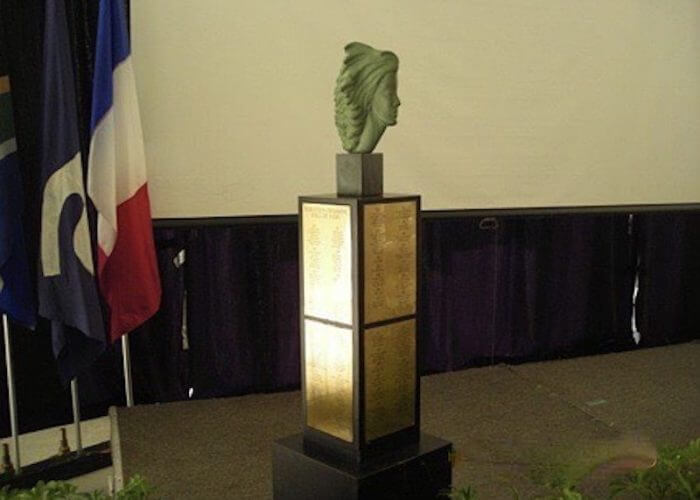
The Sea Goddess – Photo Courtesy: IMSHOF
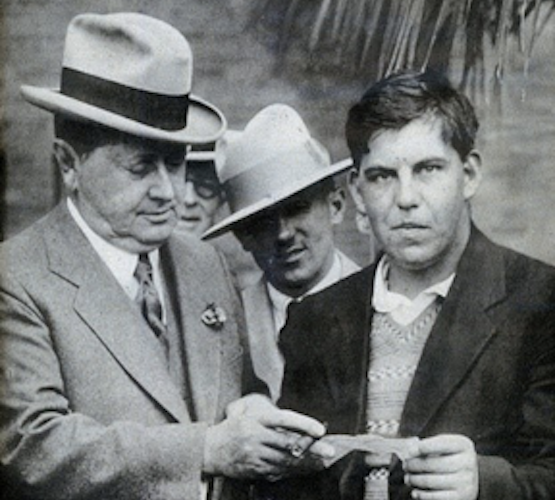
William Wrigley Jnr., left, and George Young, 1927 – Photo Courtesy: IMSHOF
Before proceeding with this thought, all acknowledge that George won the The Wrigley Ocean Marathon, that he was a great champion and his story is one of the most famous in the history of the sport.
The marathon race event was created by IMSHOF Honoree William Wrigley, Jr. the American chewing gum magnate. He bought Catalina Island and staged the 20-mile race to popularize the Island as a tourist destination – especially in the winter months. As part of the preparations, a relay team swam completed the first ever crossing the previous September in just under 24 hours.
Wrigley offered the largest ever swimming prize: $25,000 winner’s prize (worth $360,00 in 2020 terms) and $15,000 for the first female (if a man won).
The Wrigley Ocean Marathon: 158 entered and 102 (87 men/15 women) of the leading swimmers hit the water – including IMSHOF Honorees Norman Ross, Charlotte “Lottie” Schoemmell (who swam naked covered in grease) and Henry Sullivan. IMSHOF Honoree Gertrude Ederle turned down a $5,000 appearance fee. While most swam freestyle, Sullivan swam breaststroke and English Channel hero Charles Toth swam the trudgen.
George won (the only finisher) and became a hero – especially in Canada.
As a result, six months later, Wrigley then targeted the Canadian National Exhibition (CNE) with 1.5 million annual attendees for the next big prize money swim (some $80,000 – the richest race ever! – with $30,000 for the winner). Not all attendees were chewing gum customers – yet. CNE became the annual focus of professional swimming for the next two decades in Canada, North America and indeed the world. This helped inspire more Canadian prize-money swims, especially in Quebec, where such swims continue to this day.
“What if 35-year old American Charles ‘Legless Zimmy’ Zibleman had won” – asks the Sea Goddess.
Zimmy was a double amputee – and yes, it was thought possible that he might just endure and be the one who made it home to the shore at the end of The Wrigley Ocean Marathon, they full distance behind him that day.
Clearly this would have had an impact in at least six key areas:
1. Catalina Channel swimming
George was the first to complete the swim in 1927. Four swimmers followed to complete the channel swim later that year and then only two more in the next 20 years. Only by 2005 did this swim start to average more than 10 successful crossings per year. So, a one-time race in 1927 was not sufficient to cause an explosion of interest.
If the American “Zimmy” had won (see his name on boat 413 in the photo above), Wrigley may well have staged a repeat of The Wrigley Ocean Marathon in 1928. The race may well have become an annual event. With an additional boost after 1927, Catalina could well have become the world’s most prestigious and popular marathon swim 90 years ago – which may well have continued.
In 1927 the English Channel had only thirteen successful swims and only ten more in the next decade. Catalina had a few other advantages over the English Channel: Los Angeles/Hollywood versus Dover, more predictable weather (resulting in more predictable start dates), more sunshine, a longer “season”, less commercial ship traffic, just one country coast guard, less current and a faster/easier visit by swimmers from the Americas and Australia. Of note Howard James has the earliest (6 May) and latest (3 November) English Channel crossing – hence the English Channel has a “season” of less than 6 months. Recently IMSHOF Honoree Antonio Argüelles Díaz-González completed the 4th Catalina crossing in the month of January – proving a full 12 month “season”.
Much of the significance of the English Channel came from thousands of years of “physical barrier” history and an eager press in the UK for news of attempts and crossings. All the other English Channel difficulties kept the number of attempts and success rate low. This added to the mystique but probably hindered the numbers.
Other things to consider with The Wrigley Ocean Marathon in mind
- In 1927 American Gertrude Ederle (the first female to swim the English Channel – breaking the record) received the first ever ticker-tape parade in New York City. Open water swimming was BIG NEWS in the USA.
- There was a sporting club history in California. In San Francisco, the famous swimming clubs: South End Rowing Club (1873) and Dolphin Club (1877) had been in existence for more than 50 years. The Los Angeles Athletic Club and California Yacht Club both helped with the 1927 race – involving more than 225 boats. The Channel Swimming Association started in 1927 to regulate English Channel swims. Is there any question that had Wrigley continued the Catalina races on an annual basis the equivalent to the current Catalina Channel Swimming Federation would have started in 1927-1930 as opposed to the actual 1981 start date?
- In the 1950 there were sponsored English Channel races – sponsored first by The Daily Mail (newspaper) and then Butlins (holiday camps). These were typically 5 to 20 swimmers and still big UK news (with only limited global interest). The first Catalina race was more than 100 swimmers in the 1920s – and bigger news in the day in a bigger USA “market”.
- Would “Trudie” (Gertrude Ederle) have participated in 1928? She was a serious superstar. Tarzan (Johnny Weissmuller), 1924 and 1928 Olympics gold, was living in Los Angeles. He was hanging out with other swimming superstars: Buster Crabbe (California resident, 1932 gold medalist and 1933 movie star) and Duke Kahanamoku. Yes, they were sprinters, as were almost all the great marathoners of that time!
- Sea Goddess asked IMSHOF Honoree Marilyn Bell – Canadian superstar from the 1950s for her opinion: “Had Zimmy won it’s possible that Catalina would have become the epicenter of open water swimming in North America. Wrigley would have used his resources and his new hero to publicize a challenge swim without need to change the venue.”
2. Canadian marathon swimming
The explosion of interest in marathon swimming in Canada started with George’s win in The Wrigley Ocean Marathon and massive cash prizes at the CNE later that year. Without this double injection would there have been the huge public interest in Canada? Would the prize for swimming Lake Ontario been offered to Florence Chadwick in 1954 as part of the CNE without this interest? If not, then Marilyn Bell would not have been there to attract massive crowds to witness the finish nor would she have been the top Canadian newsmaker that year. And, without this swim would the famous Quebec professional swims have started shortly after?
IMSHOF Honoree Marilyn Bell continues:
“Meanwhile back in Canada, George Young would probably have found his way back to Toronto to continue supporting his Mother. Without Wrigley’s money, the Canadian National Exhibition would have remained a two-week annual fair, and Canada’s rich heritage of marathon swimming history would never have happened.”
3. English Channel swimming
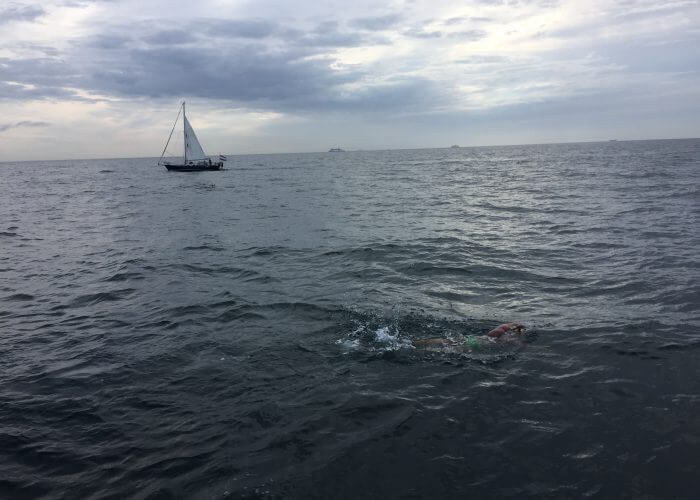
The English Channel – Photo Courtesy: Abby Bergman
It is the Mount Everest of marathon swimming. Even world champion marathon racers are drawn to this epic swim as it defines the sport. The CSA and later the CS&PF have done an excellent job in marketing the event as the toughest aquatic challenge and earned/deserve all the present esteem.
It certainly is a challenge: unpredicable weather – often poor, significant commercial ship traffic, two sets of coast guards/passports, savage cross currents, cold (compared to most other marathon swims) and unpredicable start days. There is no question in the sport that the English Channel is generally a more difficult swim than the Catalina Channel.
Imagine an annual Wrigley Ocean Marathon Catalina race of 100+ swimmers plus many solo swimmers during the other 12 months of the “season”. Mount Everest won the marketing battle in climbing, despite K2 being more difficult. Would Catalina have won the marketing battle in marathon swimming?
4. Marathon swimming in the Olympics
2008 Beijing saw the start of the 10 km open water marathon in the Olympics (112 years after swimming events at the 1896 Games in Athens were held in open water in the Bay of Piraeus over different distances. The distance of 10 km was driven by pressure to use rowing aquatic parks/small bays, often around buoys and keeping at about 2 hours. This was not the ideal concept for many in a sport that glorifies in long, epic, point-to-point swims – but it won the political battle in 2008.
Getting marathon swimming into the Olympics took a long time. A week after the 1984 Los Angeles Olympic Games, the USA Long Distance International Championships was held across the Catalina Channel, scene of the 1927 Wrigley Ocean Marathon in front of IOC and FINA executives to demonstrate the viability of a marathon swim. It helped – but it took another two plus decades.
Imagine if a 100 + Catalina race had taken place for more than fifty years – with massive international interest and participation. Who would bet that this race would not have been part of the Los Angeles Olympic and an epic/longer race is all future Olympics?
5. Zimmy
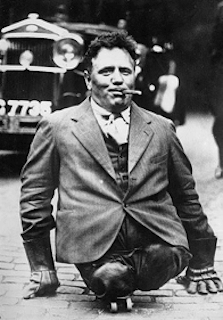
Charles Zibleman – Photo Courtesy: IMSHOF
If he had won The Wrigley Ocean Marathon in 1927, Charles Zibleman, known back then as ‘Legless Zimmy’, would have been a superstar. One can imagine Hollywood would have showcased him, somehow, in something. George Young was a naïve 17-year old country boy and was exploited by promoters. Zimmy was a 36-year old “fairly worldly” man, who worked in carnivals and as an “act” in the 1920s and who later travelled to England and Australia for marathon swims. He knew his way around the world.
It is unlikely that Zimmy would have won again but this was the era of Hollywood swimming stars. So – a few movie roles, charming actresses, society pages, hanging with local swimmers such as Johnny “Tarzan” Weissmuller, defending his trophy the next year, all that might have been a part of his world.
Achieving stardom at this stage may have resulted in Zimmy having less “to prove” in later life. His life may not have included his further exploits:
- attempted (and failed) to swim the English Channel three times in 1932 and 1933 – his time in the water ranged from nearly 11 to 18 hours.
- completed a 233 km (145-mile) staged swim down the Hudson River in 147 hours in 1937, while he never left the water, losing 12 kg (26 lbs.) during his swim.
- set the record for the longest pool swim (168 hours) ending on 24 February 1942 in Honolulu.
George Young is well known in the sport of marathon swimming. Zimmy would have, forever, been well known outside of the sport (as is Gertrude Ederle). Who would not have learned about and remembered a disabled sports star of that era?
6. Acceptance of the disabled
The sport of marathon swimming has always been quite friendly/welcoming to the disabled. Honorees (with year of induction) include: Zimmy (1966 – the third IMSHOF class), Taranath Narayan Shenoy, India (1987), Robert Cossette, Canada (2004) and James Pittar, Australia (2009). Additionally, many Honorees who have been heavily involved in supporting disabled swimmers over nearly 100 years.
This was not the case in the rest of the world as generally the disabled were not valued members. Think about American President Franklin D. Roosevelt (1936-45). The press hid his severe disability from polio from the public – who never saw him walk.
Zimmy would have changed that – early. Perhaps the world in 2020 would have been a different (more advanced/enlightened) place as a result.
Look at these key events and dates:
- 1948 the day of the Opening Ceremony of the London Olympic Games an organized the first competition for wheelchair athletes
- 1960 the 1st Summer Paralympic Games followed the Rome Olympics and used the same venues
- Special Olympics started 1968 – a different type of disability but has some relation.
These timelines would likely have been pulled forward and accelerated.
Honoree Dr. Vicki Keith, CM a leading coach of disabled swimmers commented:
“It’s hard to know how Zimmy winning could have impacted our perception. It might have created a tipping point to help us identify the possibilities instead of the challenges in living with a physical impairment. It amazes me that we are still struggling to find ways to be welcoming and inclusive in our world. With great leaders like Helen Keller, Franklin D. Roosevelt, Rick Hansen, Terry Fox, Stephen Hawking and so many more, we have proven over and over that a physical impairment does not restrict the height that one might soar.”
Any violent objections to the above should be addressed (in writing) to the empathetic ear of the 2-meter tall stone Sea Goddess in Florida. Any compliments and short story prizes to Honoree Ned Denison.
Just one final wicked thought from Sea Goddess: “What if Honoree Charlotte “Lottie” Schoemmell, clad in a bathing cap and a coat of black axle grease and nothing else had strolled out first?”




Again, please proof read and then have someone else proof read the title/captions?
We don’t have an army of sub-editors, Colleen, nor a full-time NY Times squad 🙂 The headline is fine, the captions are fine and the 4 literals in copy supplied by outside writers were corrected in the live environment within 10 mins of publication, which was 3 minutes after you left another somewhat overblown comment. Thanks for spotting the odd minor glitch in a sea of many words produced by a very small team of folk doing a terrific job. If you would like to help our small team when literals appear in copy, by all means write to editorial@Ken.com. We’d be delighted to have that kind of help. Your comments on titles are your opinion and taste, of course, not based on any error, as far as I can see, so you needn’t worry about those. Many thanks.